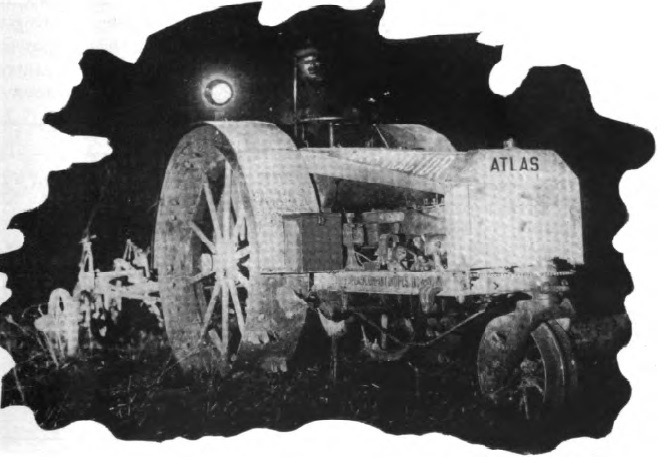One hundred years ago there were many different brands of tractors that farmers could choose from. One of these that’s never heard of today was the Atlas, which was built in Indianapolis, Indiana, by the Lyons-Atlas Company.
The Atlas tractor had its genesis in Hume, Illinois, in 1913 where the Hume Manufacturing Co., about which almost nothing can be found, built two tractor models, both with Waukesha 4-cylinder engines and a 3-wheel layout with two rear drivers and a single, centered front wheel for steering.
The Hume Junior was rated at 12-18 HP, weighed 4,600 pounds and in 1916 sold for $885.
A larger version, without the Junior name, was 20-30 HP, weighed 7,200 pounds and cost $1,350.
Meanwhile, in Indianapolis, three brothers, George, James and William Lyons, had bought the defunct Atlas Engine Works, a long-time maker of steam, gas and diesel engines, and organized the Lyons-Atlas Company.
Lyons-Atlas continued to build engines, including a version of the Knight sleeve-valve engine.
A man named Harry Knox had gone bankrupt building cars in Springfield, Massachusetts and now turned up in Indianapolis where he joined the Lyons-Atlas firm.
The result was a new Lyons-Knight car that was pretty much the same as the Atlas-Knight that Knox had gone bust building in New England.
He didn’t fare much better in Indianapolis; the Lyons-Knight cars were built only during 1913, ’14 and ’15 and there was nothing remarkable about them, although advertising claimed that the “50-horsepower silent Knight engine (was) the finest power plant ever made.”
In addition, it was expensive; prices ranged from $2,900 to more than $4,000 in the days when the most expensive Ford cost $750.
In August of 1915, the announcement was made that Harry Knox had resigned and that the Lyons-Knight automobile would be discontinued at that time.
Apparently looking for a new product, sometime during 1916 Lyons-Atlas bought the Hume Mfg. Co. and began making an improved version of the Hume tractors for 1917.
Called the Atlas, the new tractor was the spittin’ image of the old Hume, even down to the Waukesha engines even though Lyons-Atlas was building the Knight engine at the time.
For 1917, Lyons-Atlas offered the 12-18, now listed as weighing 4,600 pounds and costing $1,150, while the old Hume 20-30 was downgraded to 12-20 HP, weighed 7,200 pounds and cost $1,745.
Again, expensive tractors at the time as a Waterloo Boy 12-25 cost $850 and an IH Mogul 10-20 sold for $950.
The price of the Atlas tractors may have been part of the reason the Lyons were soon in financial difficulty and in early 1918 they merged with the Midwest Engine Company and the Hill Pump Company, both of Indianapolis.
An article in the September 1918 issue of Tractor World magazine described the latest Atlas tractor as built by Midwest Engine Company. “The Atlas tractor is a three-wheel machine, a small wheel in a castor carrying the front end, while the two driving wheels are 66 inches diameter with 12-inch faces. The claim is made that the tractor can be turned in a radius of nine feet, so it can be operated in a very small place and the corners of fields can be plowed without difficulty.
“The tractor is rated for 16 HP at the drawbar and 26 HP for belt power. Statement is made that the tractor will draw three 14-inch plows to a depth of at least seven inches, haul two 7-foot tandem discs, two binders, drive a 26 or 28-inch separator, a 16-inch ensilage cutter, and that it has a drawbar pull of 2800 pounds at plowing speed, 2 MPH.”
The Waukesha L-head engine had the cylinders cast in pairs with a bore and stroke of 4 inches by 5 inches and “The maker claims for this engine at this speed (1000 RPM) a horsepower of 32.50.”
The 1918 account went on, “Between the driving wheels is the steering wheel, which is an automobile type, and the control levers are on the steering column and at either side, convenient to the operator. The frame is decked between the wheel guards and the sulky seat is on a spring steel support that is fitted into a socket and can be lifted out when necessary.”
Optional accessories included a “self-guide, which steers the machine while plowing and ensures straight furrows,” while, unusual for 1918, the Atlas tractor could be “equipped with an electric lighting system when desired, this consisting of a generator and storage battery.
“The battery being mounted on spring brackets and in a dust proof box, large head lamps on swivel brackets and a trouble lamp with 40 feet of cable. With this equipment, the tractor may be used at night, even driven almost continuously.”
The Atlas tractor was still listed in the 1919 Tractor Field Book, but the machine never seemed to catch on with farmers.
By 1920 Midwest Engine Company had scrapped the Atlas tractor and was concentrating on the Midwest Utilitor, a 1-horsepower, two-wheeled garden tractor that cost just $345 and with which the firm had some success, building the Utilitor into the late 1930s.
The Hume and the Atlas tractors are just two of the many tractor marques that were introduced, hyped, lasted a year or two, died and were forgotten during the decade from 1915 to 1925.
We’ll take a look at some of the others in future columns.













